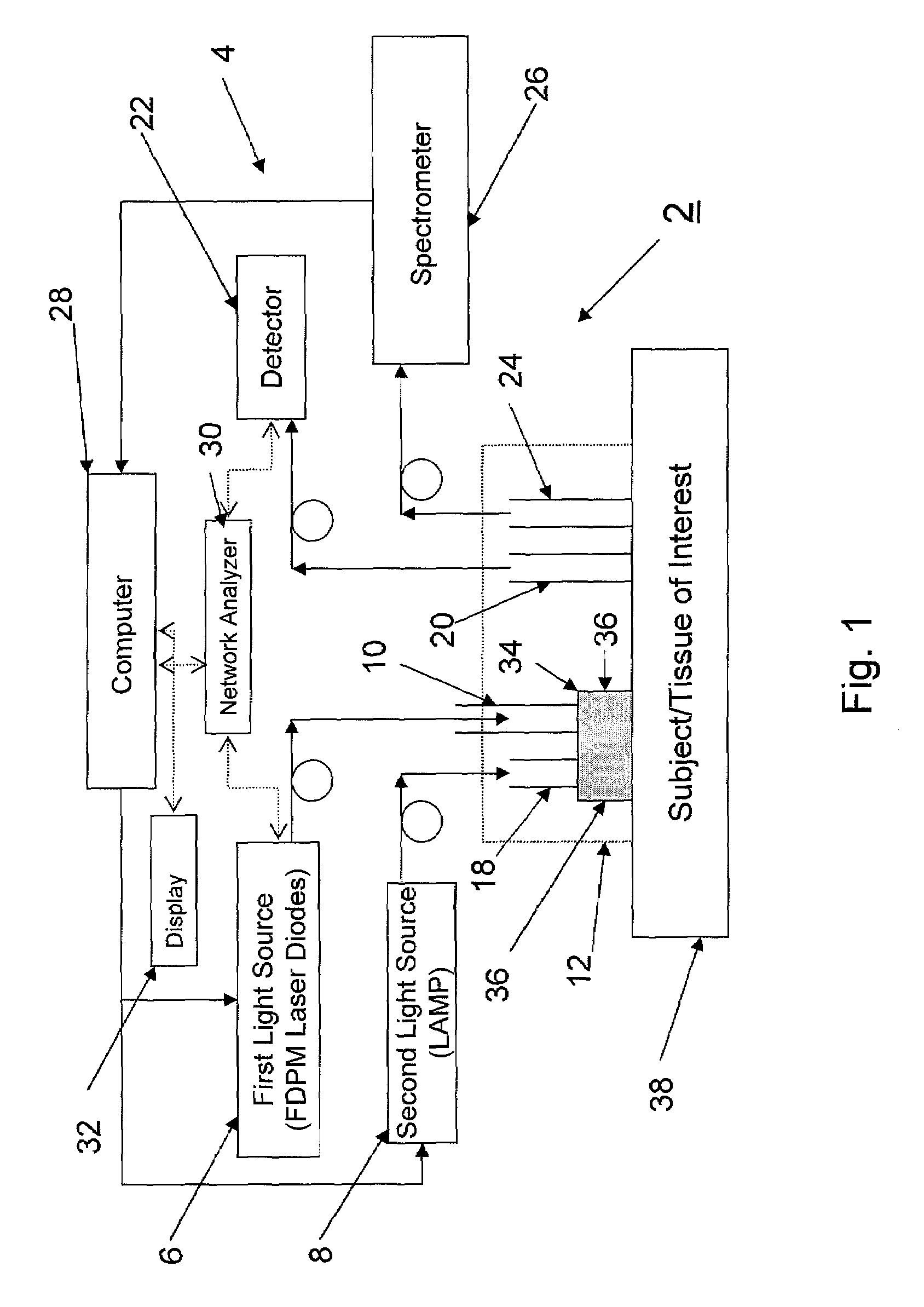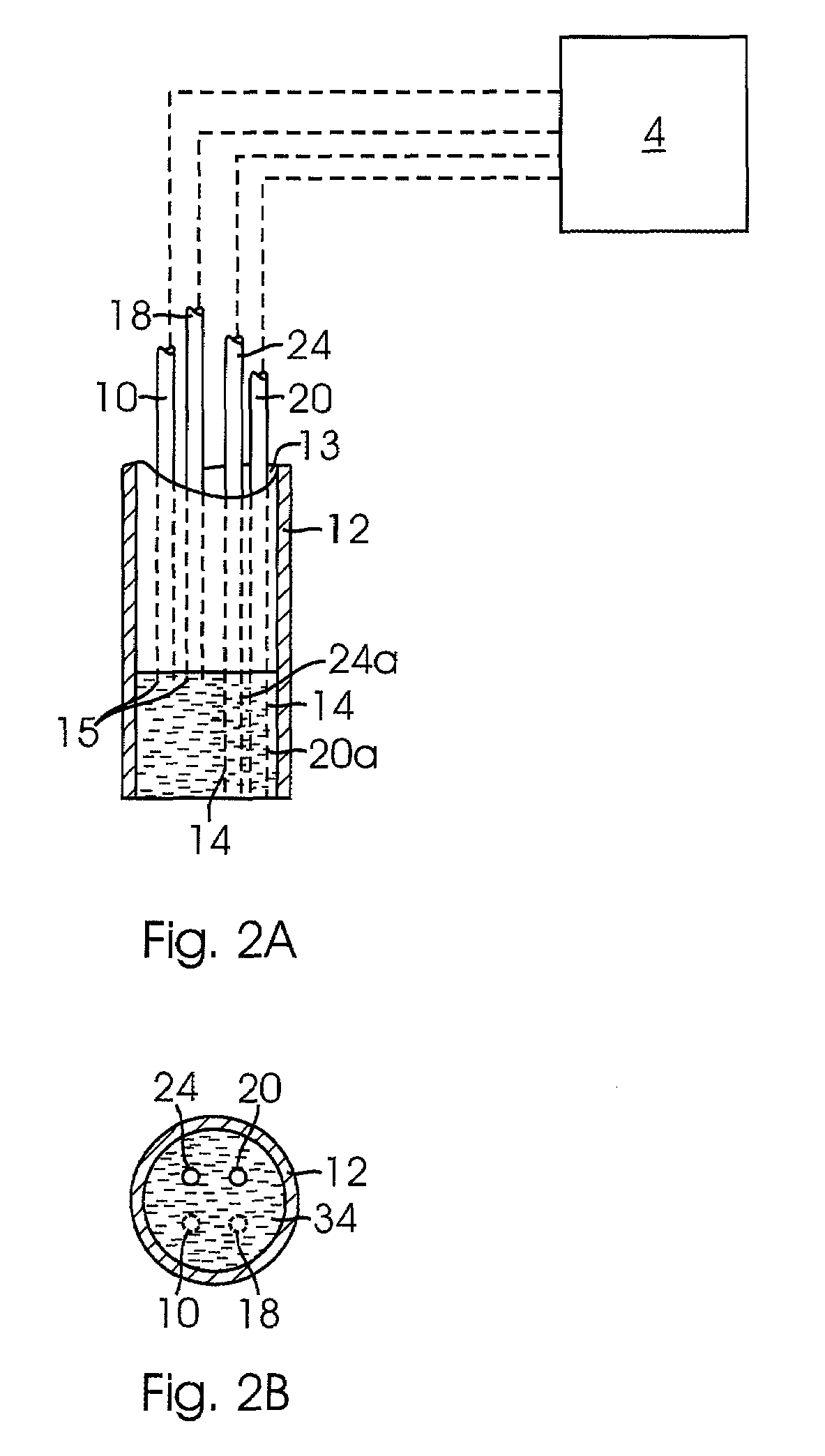Method and apparatus for quantification of optical properties of superficial volumes
a superficial volume and optical property technology, applied in the field of devices, can solve the problems of inaccuracy in methods, limited current diffuse optical spectroscopy methods, and inability to accurately quantify tissue optical properties and chromophore concentrations, so as to reduce the separation distance between source and detector, reduce the effect of scattering and low absorption material
- Summary
- Abstract
- Description
- Claims
- Application Information
AI Technical Summary
Benefits of technology
Problems solved by technology
Method used
Image
Examples
experiment 1
[0079]A DOS system 2 utilizing a diffuser 34 (in the form of a layer) was used to demonstrate that the validity of the diffusion approximation is maintained even as the source-detector separation distance is reduced to a distance of 2.5 mm. Frequency domain measurements were made at several wavelengths to recover the optical properties of tissue phantoms, using a two-layer model for which the optical properties and thickness of the upper, highly scattering layer were known.
[0080]In this approach, a high scattering, low absorption diffuser 34 layer was interposed between the distal end of the source optical fiber 10 and the sample source layer 38 (μs′=9 mm−1 and μa=0.0015 mm−1 at 661 nm). The diffuser 34 layer effectively increased the photon path length and allowed the source-detector separation to be made arbitrarily small. The general operation of the multi-wavelength frequency-domain spectroscopy system 2 is described in F. Bevilacqua, A. J. Berger, A. E. Cerussi, D. Jakubowski, ...
experiment 2
[0091]In a conventional DOS measurement in which the source optical fiber 10 and the detector optical fiber 20 are flush with sample 38 under investigation, a standard diffusion model is generally employed to recover sample's optical properties for its simplicity and efficiency. Unfortunately, the standard diffusion model is feasible only when the sample under investigation has μs′ / μa>10 and the source optical fiber 10 and detector optical fiber 20 separation distance is much larger than 1 / (μs′+μa). In some applications, for example, measuring skin melanin concentration using NIR light, samples 38 have μs′ on the same order of μa, and the standard diffusion equation typically used is not appropriate for recovering optical properties of such samples 38.
[0092]The modified two-layer (MTL) geometry described herein uses a diffuser 34 in the form of a very high scattering top layer to make light radiance isotropic in a very short distance (1-2 mm). By using the diffuser 34, a diffusion m...
experiment 3
[0095]The optical properties (μs′, μa) of human skin were determined by using MTL-based DOS system 2. Measurements were made in vivo in a non-invasive manner. In this experiment, the optical properties of forearm skin of three healthy subjects were measured. The subjects were of African, Caucasian, and Asian descent. The optical properties (μs′, μa) were determined at four different wavelengths using the DOS system 2 described herein. FIGS. 13A and 13B illustrate the measured optical properties (μs′, μa) as a function of the different wavelengths for each subject. The measured μa of the forearm skin of the African subject is much higher than those of the other two subjects (around 500% higher at 660 nm). In contrast, the μs′ of the skin of the three subjects were generally close to one another (generally within 10% for most of wavelengths). It is believed that the μa differences in this wavelength range are mainly due to the differences in melanin concentration of three subjects. Co...
PUM
| Property | Measurement | Unit |
|---|---|---|
| wavelength | aaaaa | aaaaa |
| wavelength | aaaaa | aaaaa |
| wavelength | aaaaa | aaaaa |
Abstract
Description
Claims
Application Information
 Login to View More
Login to View More - R&D
- Intellectual Property
- Life Sciences
- Materials
- Tech Scout
- Unparalleled Data Quality
- Higher Quality Content
- 60% Fewer Hallucinations
Browse by: Latest US Patents, China's latest patents, Technical Efficacy Thesaurus, Application Domain, Technology Topic, Popular Technical Reports.
© 2025 PatSnap. All rights reserved.Legal|Privacy policy|Modern Slavery Act Transparency Statement|Sitemap|About US| Contact US: help@patsnap.com



